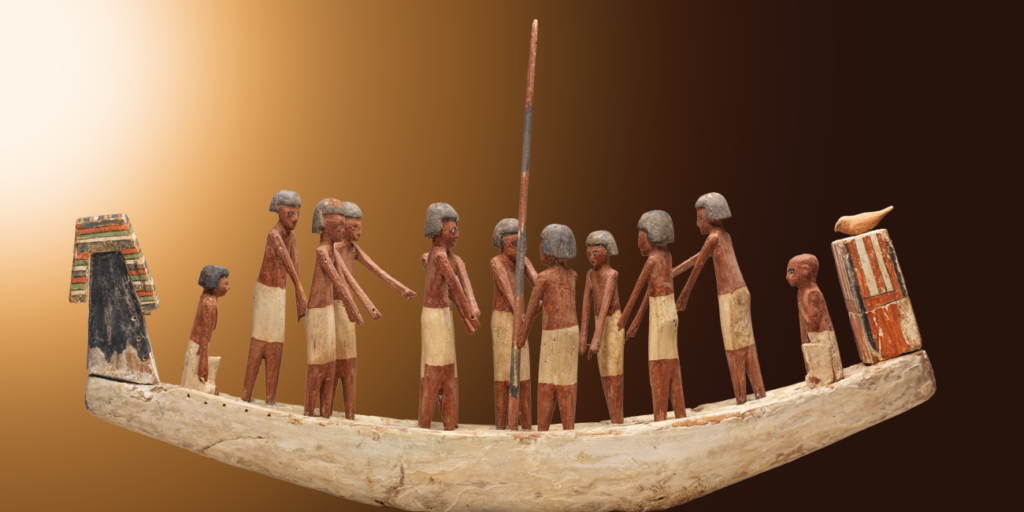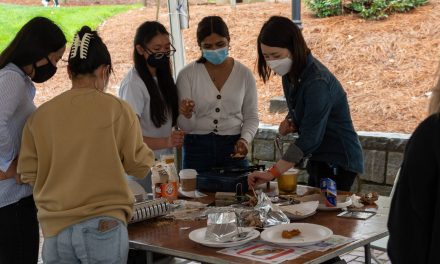Chances are, you have at least a little bit of time in between your classes or on the weekend. Amid the daily monotony of school, socializing and incessant phone scrolling, you would benefit from a visit to the Carlos Museum’s newest exhibit “Life and the Afterlife,” which opened on Feb. 4 and runs until Aug. 6. It doesn’t matter whether you’re a “museum person” or not; with its variety of subjects and interactive interfaces, this exhibit is for everyone.
Following the exhibition on ancient gem engraving, the “Life and the Afterlife of Ancient Egypt” exhibit attempts to depict the ancient village, Hetep-Senusret—modern-day Faiyum, Egypt—which derives its name from King Senusret II (~1897-1878 BCE). The installation is situated on the top floor of the museum, right across from the Ébrīk coffee shop. The space provides a serene silence; a nice cup of coffee would pair well with a stroll through the exhibition. Or, perhaps one could take a breather among various ancient artifacts after some studying at one of the cafe’s tables. Either way, the entrance and interior of the “Life and the Afterlife” exhibition is ideal for concentration and decompression.

Courtesy of the Michael C. Carlos Museum
Of course, there are various ways to travel through an exhibition. Most people glance at each piece for a moment, maybe referring to the curator’s notes for some guidance, before moving on with their lives. While it’s great if you just want to let yourself zone out, it’s also interesting to consider how the exhibition curator has set up the space to guide your attention. An in-person museum visit has the unique advantage of offering you the space for critical thinking in a way that consuming content online does not. You can do so in ways as simple as taking note of how you walk through an exhibit.
I kept this in mind as best as I could and generated some interesting observations. There are three main rooms: the closest to Ébrīk is the lifestyle-focused section, religious iconography is in the second room and funerary practices are in the third. If you peek your head past the partition that faces the exhibition’s front doors, you may notice that the overhead lighting dims the farther you go through the space, seemingly to represent the transition from life to afterlife.
A similarly-placed partition appears in the third room so as to more gradually reveal items and their significances rather than an open, unobstructed space. To the immediate left and right of the first room are some items I found to be delightfully refreshing among all the refined ancient art. The Museum’s Curator of Ancient Egyptian, Nubian and Near Eastern Art Melinda Hartwig was clever in grouping together a chisel, mallet and an unfinished statue so as to give a glimpse into the work of a sculptor. If you find this sort of grouping familiar, then you might have visited the Carlos Museum’s permanent Ancient Nubian, Egyptian and Near Eastern collections that Hartwig also curated.
Interactive interfaces such as videos, iPads and graphics broke up the monotony of curator notes. One iPad I reviewed provided digital mapping of the mummified Osiris priestess Taosiris and explained different preservation practices that were used on her body. The second room—my favorite—showcased statues of various gods, many of them standing underneath a great map that showed their excavation sites and locations where they were historically prevalent. The provenances for almost all of the pieces in the exhibition were otherwise vague without much if any indication of their excavation sites, likely given that the Georges Ricard Foundation collections are private.
One of the difficulties with curation stems from large donations or loans. Occasionally, some pieces don’t belong to a specific civilization nor time period but still must be displayed. This is the case for the Senusret collection. Many pieces date to the Ptolemaic period when Alexander the Great’s general, Ptolemy, took over Egyptian rule around 300 BCE, roughly 1500 years after Senusret II. I also encountered various Roman, Greek and Nubian works. These civilizations had their own bouts of Egyptomania and attempted to mimic various artforms. The average visitor would mistake such imitations as genuine. Other pieces aren’t Egyptian at all. The first exhibit room featured a wall for Ancient Greek and Roman life, showcasing amphorae—lithe, handled pots that stored and transported goods—as well as various metallic coins, perfume bottles, pitchers and bowls.
There even stood a case that contained 19th century, Egyptomania era European pieces. Regardless, I commend Hartwig for grouping pieces as best as possible in terms of relevance and storytelling.
Again, the subject shifts throughout the exhibition’s rooms from daily life all the way to funerary rites. So, if you want to see a mummy, you’ll see a mummy. With the U.S. being one several Egyptomaniac countries, many are drawn to the timeless craft of Ancient Egyptian embalming and mummification. Perhaps this curiosity is what leads the average visitor to the end of the space, or maybe the handful of udjat eyes—individually known as the eye of Horus—that dot the second room’s walls and display cases. I watched two toddlers make a beeline to the final room where Taosiris’s mummified remains and sarcophagus lay, their parents in tow. Their tip-tapping broke the otherwise silent space, though in a refreshing way that loosened the polite environment.
I won’t reveal anything more so you can see Ancient Egyptian burial figures and practices for yourself. And remember: you are the one who determines your museum experience! It can be a visit to take your mind off of daily stressors or maybe to practice critical thinking skills.





